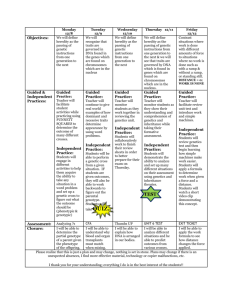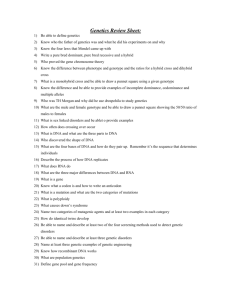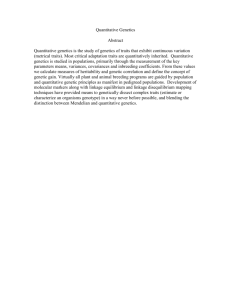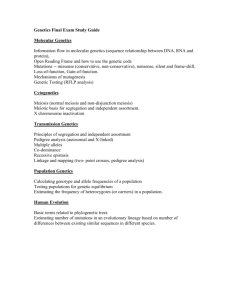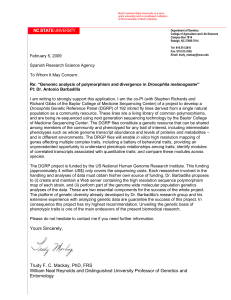Chapter 2 – Evolutionary Computing: The Origins
advertisement
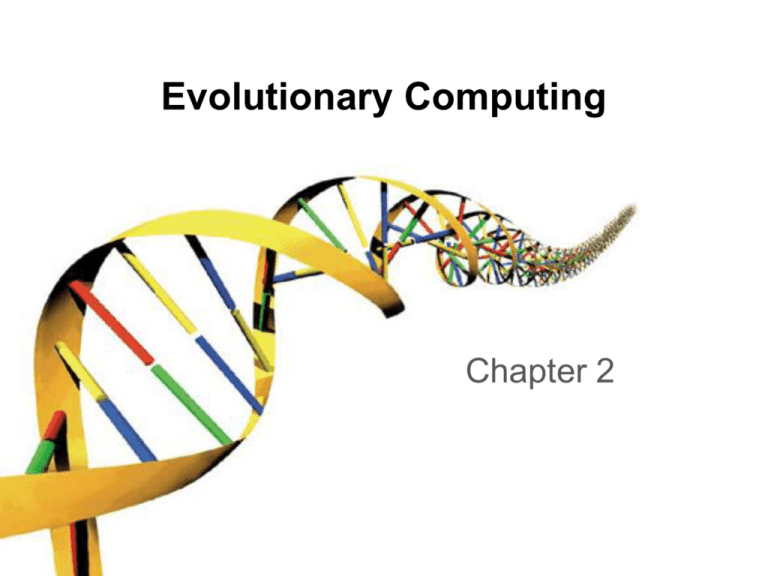
Evolutionary Computing Chapter 2 Chapter 2: Evolutionary Computing: the Origins • Historical perspective • Biological inspiration: – Darwinian evolution theory (simplified!) – Genetics (simplified!) • Motivation for EC 2 / 24 Historical perspective (1/3) • 1948, Turing: proposes “genetical or evolutionary search” • 1962, Bremermann: optimization through evolution and recombination • 1964, Rechenberg: introduces evolution strategies • 1965, L. Fogel, Owens and Walsh: introduce evolutionary programming • 1975, Holland: introduces genetic algorithms • 1992, Koza: introduces genetic programming 3 / 24 Historical perspective (2/3) • 1985: first international conference (ICGA) • 1990: first international conference in Europe (PPSN) • 1993: first scientific EC journal (MIT Press) • 1997: launch of European EC Research Network EvoNet 4 / 24 Historical perspective (3/3) EC in the early 21st Century: • 3 major EC conferences, about 10 small related ones • 4 scientific core EC journals • 1000+ EC-related papers published last year(estimate) • uncountable (meaning: many) applications • uncountable (meaning: ?) consultancy and R&D firms • part of many university curricula 5 / 24 Darwinian Evolution (1/3): Survival of the fittest • All environments have finite resources (i.e., can only support a limited number of individuals) • Life forms have basic instinct/ lifecycles geared towards reproduction • Therefore some kind of selection is inevitable • Those individuals that compete for the resources most effectively have increased chance of reproduction • Note: fitness in natural evolution is a derived, secondary measure, i.e., we (humans) assign a high fitness to individuals with many offspring 6 / 24 Darwinian Evolution (2/3): Diversity drives change • Phenotypic traits: – Behaviour / physical differences that affect response to environment – Partly determined by inheritance, partly by factors during development – Unique to each individual, partly as a result of random changes • If phenotypic traits: – Lead to higher chances of reproduction – Can be inherited then they will tend to increase in subsequent generations, leading to new combinations of traits … 7 / 24 Darwinian Evolution (3/3): Summary • Population consists of diverse set of individuals • Combinations of traits that are better adapted tend to increase representation in population Individuals are “units of selection” • Variations occur through random changes yielding constant source of diversity, coupled with selection means that: Population is the “unit of evolution” • Note the absence of “guiding force” 8 / 24 Adaptive landscape metaphor (Wright, 1932) • Can envisage population with n traits as existing in a n+1-dimensional space (landscape) with height corresponding to fitness • Each different individual (phenotype) represents a single point on the landscape • Population is therefore a “cloud” of points, moving on the landscape over time as it evolves – adaptation 9 / 24 Adaptive landscape metaphor (Wright, 1932) 10 / 24 Adaptive landscape metaphor (cont’d) • Selection “pushes” population up the landscape • Genetic drift: • random variations in feature distribution • (+ or -) arising from sampling error • can cause the population “melt down” hills, thus crossing valleys and leaving local optima 11 / 24 Genetics: Natural • The information required to build a living organism is coded in the DNA of that organism • Genotype (DNA inside) determines phenotype • Genes phenotypic traits is a complex mapping – One gene may affect many traits (pleiotropy) – Many genes may affect one trait (polygeny) • Small changes in the genotype lead to small changes in the organism (e.g., height, hair colour) 12 / 24 Genetics: Genes and the Genome • Genes are encoded in strands of DNA called chromosomes • In most cells, there are two copies of each chromosome (diploidy) • The complete genetic material in an individual’s genotype is called the Genome • Within a species, most of the genetic material is the same 13 / 24 Genetics: Example: Homo Sapiens • Human DNA is organised into chromosomes • Human body cells contains 23 pairs of chromosomes which together define the physical attributes of the individual: 14 / 24 Genetics: Reproductive Cells • Gametes (sperm and egg cells) contain 23 individual chromosomes rather than 23 pairs • Cells with only one copy of each chromosome are called haploid • Gametes are formed by a special form of cell splitting called meiosis • During meiosis the pairs of chromosome undergo an operation called crossing-over 15 / 24 Genetics: Crossing-over during meiosis • • Chromosome pairs align and duplicate Inner pairs link at a centromere and swap parts of themselves • • Outcome is one copy of maternal/paternal chromosome plus two entirely new combinations After crossing-over one of each pair goes into each gamete 16 / 24 Genetics: Fertilisation Sperm cell from Father Egg cell from Mother New person cell (zygote) 17 / 24 Genetics: After fertilisation • New zygote rapidly divides etc creating many cells all with the same genetic contents • Although all cells contain the same genes, depending on, for example where they are in the organism, they will behave differently • This process of differential behaviour during development is called ontogenesis • All of this uses, and is controlled by, the same mechanism for decoding the genes in DNA 18 / 24 Genetics: Genetic code • All proteins in life on earth are composed of sequences built from 20 different amino acids • DNA is built from four nucleotides in a double helix spiral: purines A,G; pyrimidines T,C • Triplets of these from codons, each of which codes for a specific amino acid • Much redundancy: • • • • purines complement pyrimidines the DNA contains much rubbish 43=64 codons code for 20 amino acids genetic code = the mapping from codons to amino acids • For all natural life on earth, the genetic code is the same ! 19 / 24 Genetics: Transcription, translation A central claim in molecular genetics: only one way flow Genotype Phenotype Genotype Phenotype Lamarckism (saying that acquired features can be inherited) is thus wrong! 20 / 24 Genetics: Mutation • Occasionally some of the genetic material changes very slightly during this process (replication error) • This means that the child might have genetic material information not inherited from either parent • This can be – catastrophic: offspring in not viable (most likely) – neutral: new feature not influences fitness – advantageous: strong new feature occurs • Redundancy in the genetic code forms a good way of error checking 21 / 24 Motivation for evolutionary computing (1/2) • Nature has always served as a source of inspiration for engineers and scientists The best problem solver known in nature is: • – – • • the (human) brain that created “the wheel, New York, wars and so on” (after Douglas Adams’ Hitch-Hikers Guide) the evolution mechanism that created the human brain (after Darwin’s Origin of Species) Answer 1 neurocomputing Answer 2 evolutionary computing 22 / 24 Motivation for evolutionary computing (2/2) • Developing, analyzing, applying problem solving methods a.k.a. algorithms is a central theme in mathematics and computer science • Time for thorough problem analysis decreases • Complexity of problems to be solved increases • Consequence: ROBUST PROBLEM SOLVING technology needed 23 / 24 A.E. Eiben and J.E. Smith, Introduction to Evolutionary Computing 2014, Chapter 2 24



